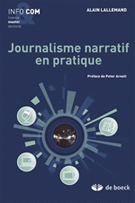America tends to get credit for adding narrative journalism to the literary canon. And there’s no doubt that the combination of timely reporting and timeless writing took on new and exciting forms in the U.S. in the second half of the 20th century. But that movement grew out of more than a thousand years of narrative nonfiction in other parts of the world. And many overseas journalists have been ambitiously reversing the trend in recent years, working to develop or refine their own cultures of narrative reporting.
 2009 Nieman Fellow Graciela Mochkofsky and affiliate Gabriel Pasquini returned to Argentina after their fellowship year to co-launch the site el puercoespín (The Porcupine), which looks at excellent storytelling in many forms, with a particular interest in narrative nonfiction. (They’re working really cross-culturally, offering Spanish translations of Jon Lee Anderson’s New Yorker articles.) And then there’s Periodismo narrativo en Latinoamérica, a blog-which highlights great storytelling journalism from both American continents.
2009 Nieman Fellow Graciela Mochkofsky and affiliate Gabriel Pasquini returned to Argentina after their fellowship year to co-launch the site el puercoespín (The Porcupine), which looks at excellent storytelling in many forms, with a particular interest in narrative nonfiction. (They’re working really cross-culturally, offering Spanish translations of Jon Lee Anderson’s New Yorker articles.) And then there’s Periodismo narrativo en Latinoamérica, a blog-which highlights great storytelling journalism from both American continents.
Spanish newspaper El País offers the Ortega y Gasset prize annually, which often includes winners with a storytelling focus. (Submissions are now being accepted for this year’s prize.) The Iberoamerican Foundation for New Journalism (FNPI), created by writer and Nobel Prize winner Gabriel García Márquez, similarly holds an enormous competition for Spanish and Portuguese journalists, and tends to choose winners with strong narrative elements. FNPI is hosting a narrative journalism workshop in April run by Leila Guerriero, who took the Foundation’s prize in 2010.
In Bucharest, Cristian Lupsa is producing Decât o Revista (Just a Magazine) and running a narrative conference that sold out in 2011.Laurens Nijzink, a multimedia storyteller in the Netherlands, put together another narrative conference in Amsterdam last year.
A how-to manual for Francophone journalists
There are a lot of English-language texts on how to produce top-notch narratives (see our own “Telling True Stories,” as well as many other books). But where English is not the dominant language (and where narrative does not have a long history), working journalists and rising reporters have little choice but to learn on the fly and get advice as they can from practitioners with more narrative experience.
Enter Alain Lallemand, a professor at the Catholic University of Leuven and longtime investigative reporter for Le Soir, a Belgian newspaper. Lallemand has written a college textbook in French, “Journalisme narratif en pratique,” which was recently published by De Boeck editions.
 “Keep in mind,” Lallemand said via email, “that in the French-speaking culture, narrative journalism has been identified very lately – within the last decade, not before – and in most universities, is not even taught.”
“Keep in mind,” Lallemand said via email, “that in the French-speaking culture, narrative journalism has been identified very lately – within the last decade, not before – and in most universities, is not even taught.”
To create a how-to manual for narrative journalism, Lallemand touches all the bases. He outlines the ingredients of a good story, describes how to create scenes, addresses some of the core tools most useful to storytellers, and even takes on the tricky McGuffin (some words just can’t be translated). Sections of the book are dedicated to emerging nonlinear narratives and to consideration of narrative ethics, with mini case studies.
Lallemand’s index references everything from Hemingway and Tolstoy to material published here on Storyboard. He builds out from Tom Wolfe’s “new journalism” and the new new journalism of “Actuel,” a counter-culture idea magazine published in France from the late 1960s to the early 1990s. Emphasizing immersion and participatory journalism, Lallemand pays special attention to on-the-ground reporting covering conflict and humanitarian crises.
And what will happen now that French-speaking journalists and J-school instructors have a how-to manual of their own? “For most Paris-based academics, ‘storytelling’ is still perceived as a sub-field of marketing and propaganda,” Lallemand said. “I hope this book will be a game-changer.”
We’re sure there are many other storytellers around the globe trying to develop or expand narrative journalism in their home countries, whether the final creation is written or visual (or both). We’d love to hear from those outside the United States who are building narrative tools, projects and networks, and to learn more about the challenges they encounter and the results of their work.


